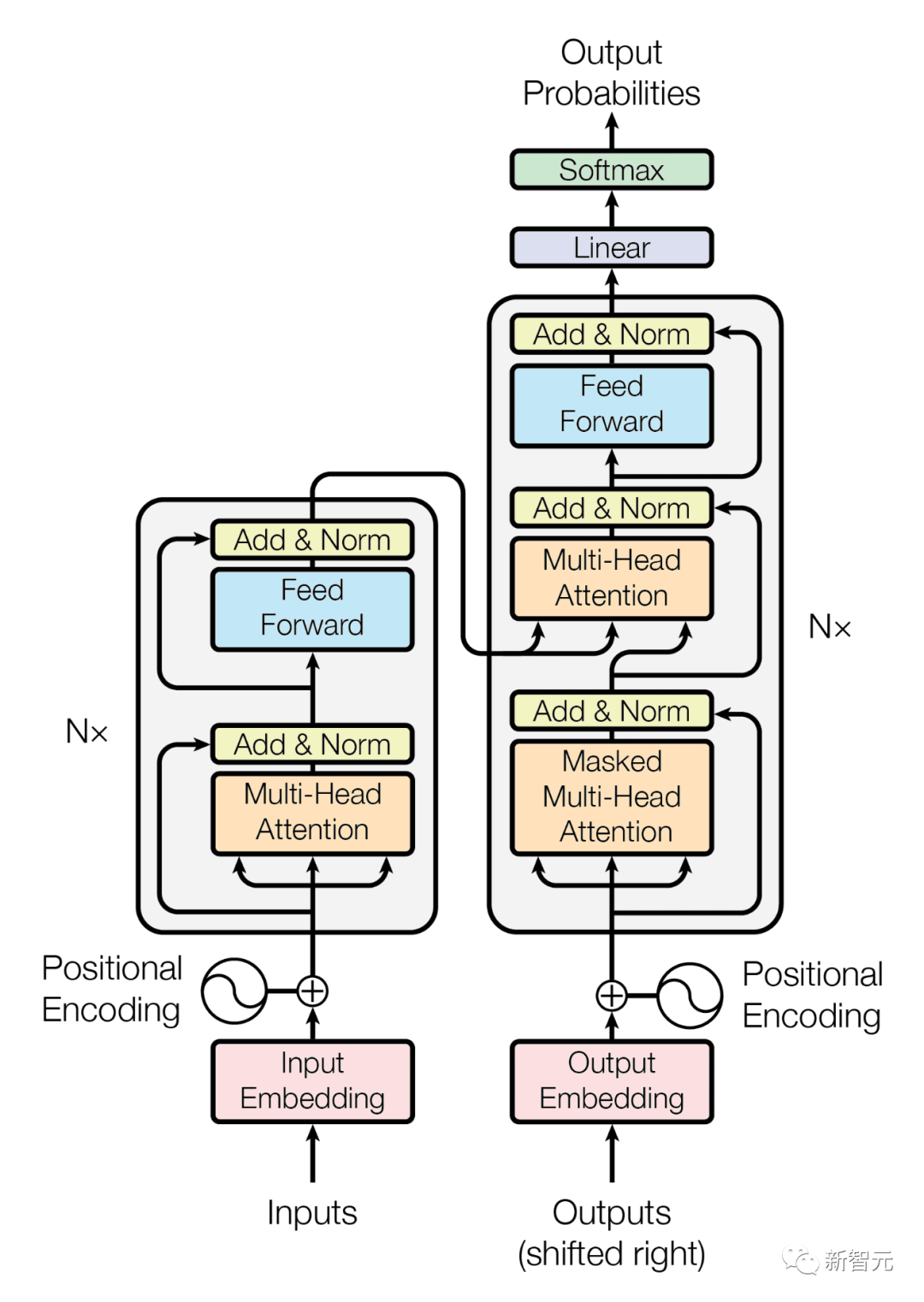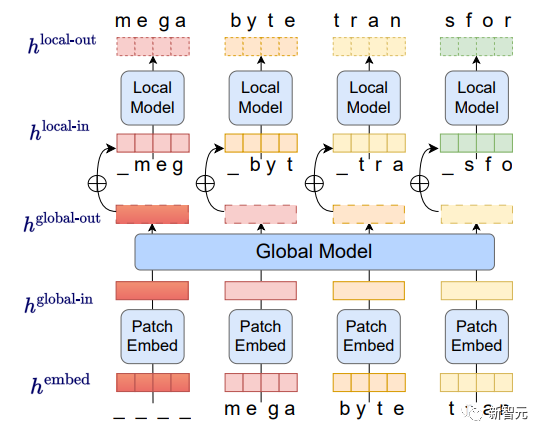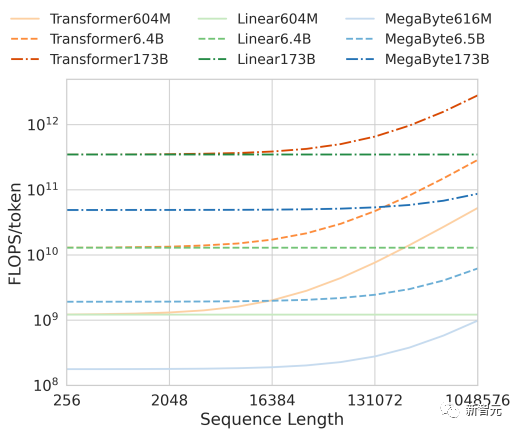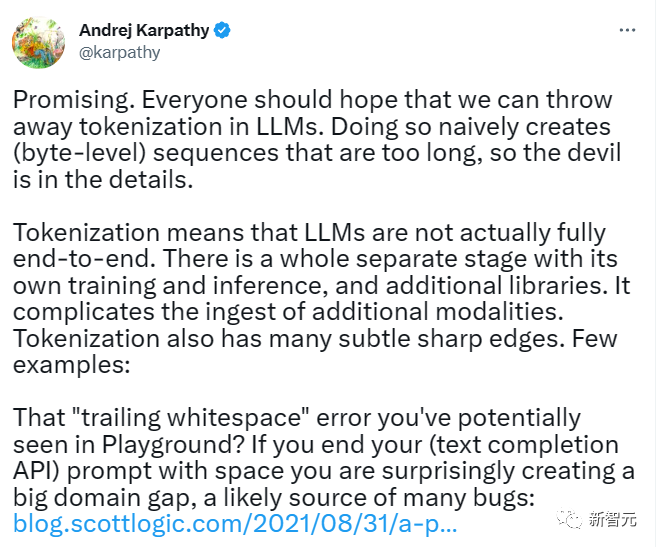 Technology peripherals
Technology peripherals
 AI
AI
 40% faster than Transformer! Meta releases new Megabyte model to solve the problem of computing power loss
40% faster than Transformer! Meta releases new Megabyte model to solve the problem of computing power loss
40% faster than Transformer! Meta releases new Megabyte model to solve the problem of computing power loss
Transformer is undoubtedly the most popular model in the field of machine learning in the past few years.
Since it was proposed in the paper "Attention is All You Need" in 2017, this new network structure has exceeded all major translation tasks and created many new records. .

But Transformer has a flaw when processing long byte sequences, that is, the computing power is seriously lost, and Meta’s The latest results of researchers can solve this shortcoming well.
They have launched a new model architecture that can generate more than 1 million tokens across multiple formats and surpass the capabilities of the existing Transformer architecture behind models such as GPT-4.
This model is called "Megabyte" and is a multi-scale decoder architecture that can process more than one million bytes. The sequence is end-to-end differentiable modeling.

##Paper link: https://arxiv.org/abs/2305.07185
Why Megabyte is better than Transformer, you must first look at the shortcomings of Transformer.
Disadvantages of TransformerSo far, several types of high-performance generative AI models, such as OpenAI’s GPT-4 and Google’s Bard, are all based on the Transformer architecture. Model.
But Meta’s research team believes that the popular Transformer architecture may be reaching its threshold, mainly due to two important flaws inherent in the Transformer design:
- As the input and output byte lengths increase, the cost of self-attention also increases rapidly. For example, input music, image or video files usually contain several megabytes. However, large decoders (LLM) often Using only a few thousand contextual tokens
- Feed-forward networks help language models understand and process words through a series of mathematical operations and transformations, but are difficult to scale on a per-position basis nature, these networks operate on character groups or positions independently, resulting in a large amount of computational overhead
What is the strength of MegabyteCompared with Transformer, the Megabyte model shows A uniquely different architecture that divides input and output sequences into patches instead of individual tokens.
As shown below, in each patch, the local AI model generates results, while the global model manages and coordinates the final output of all patches.

First, the byte sequence is divided into fixed-size patches, roughly similar to tokens. This model consists of three parts Composition:
The researchers observed that byte prediction is relatively easy for most tasks (such as completing a word given the first few characters), which means that each word Large networks of knots are unnecessary and smaller models can be used for internal predictions.#(1) patch embedder: simply encode patch
## by losslessly concatenating the embeddings of each byte #(2) A global model: a large autoregressive transformer represented by the input and output patches(3) A local model: a small autoregressive model that predicts the bytes in the patch
This approach solves the scalability challenges prevalent in today’s AI models. The Megabyte model’s patch system allows a single feedforward network to run on patches containing multiple tokens, effectively solving the problem of self-attention. Scaling issue. Among them, the Megabyte architecture has made three major improvements to the Transformer for long sequence modeling: - Quadratic self-attention (Sub -quadratic self-attention) Most work on long sequence models has focused on mitigating the quadratic cost of self-attention, while Megabyte breaks the long sequence into two shorter sequences that are still easy to handle even for long sequences. - patch feedforward layers (Per-patch feedforward layers) Over 98% FLOPS in GPT-3 sized models For computing positional feedforward layers, Megabyte uses large feedforward layers per patch to achieve larger, more performant models at the same cost. With a patch size of P, the baseline converter will use the same feedforward layer with m parameters P times, and Megabyte can use a layer with mP parameters once at the same cost. -Parallelism in Decoding Transformers must perform all calculations serially during generation because each time The input to a step is the output of the previous time step, and by generating patch representations in parallel, Megabyte allows for greater parallelism in the generation process. For example, a Megabyte model with 1.5B parameters generates sequences 40% faster than a standard 350MTransformer, while also improving perplexity when using the same amount of computation to train. Megabyte far outperforms other models and provides results competitive with the sota model trained on subwords In comparison, OpenAI’s GPT-4 has a 32,000 token limit, and Anthropic’s Claude has a 100,000 token limit. In addition, in terms of computational efficiency, within a fixed model size and sequence length range, Megabyte uses fewer tokens than Transformers and Linear Transformers of the same size, allowing the same computational cost. Use a larger model. 

Together, these improvements allow us to train under the same computational budget Larger, better-performing models that scale to very long sequences and increase build speed during deployment.
What will the future look like
With the AI arms race in full swing, model performance is getting stronger and stronger, and parameters are getting higher and higher.
While GPT-3.5 was trained on 175B parameters, some speculate that the more powerful GPT-4 was trained on 1 trillion parameters.
OpenAI CEO Sam Altman also recently suggested a change in strategy. He said that the company is considering abandoning the training of huge models and focusing on other performance optimizations.
He equates the future of AI models to iPhone chips, while most consumers know nothing about the original technical specifications.
Meta researchers believe their innovative architecture comes at the right time, but admit there are other avenues for optimization.
For example, a more efficient encoder model using patching technology, a decoding model that decomposes the sequence into smaller blocks, and preprocessing the sequence into a compressed token, etc., and can extend the existing Transformer Architectural capabilities to build next-generation models.
Former Tesla AI director Andrej Karpathy also expressed his views on this paper. He wrote on Twitter:
This is very promising and everyone should be hoping that we can throw away tokenization in large models and eliminate the need for those long byte sequences.

The above is the detailed content of 40% faster than Transformer! Meta releases new Megabyte model to solve the problem of computing power loss. For more information, please follow other related articles on the PHP Chinese website!

Hot AI Tools

Undresser.AI Undress
AI-powered app for creating realistic nude photos

AI Clothes Remover
Online AI tool for removing clothes from photos.

Undress AI Tool
Undress images for free

Clothoff.io
AI clothes remover

AI Hentai Generator
Generate AI Hentai for free.

Hot Article

Hot Tools

Notepad++7.3.1
Easy-to-use and free code editor

SublimeText3 Chinese version
Chinese version, very easy to use

Zend Studio 13.0.1
Powerful PHP integrated development environment

Dreamweaver CS6
Visual web development tools

SublimeText3 Mac version
God-level code editing software (SublimeText3)

Hot Topics
 1377
1377
 52
52
 The world's most powerful open source MoE model is here, with Chinese capabilities comparable to GPT-4, and the price is only nearly one percent of GPT-4-Turbo
May 07, 2024 pm 04:13 PM
The world's most powerful open source MoE model is here, with Chinese capabilities comparable to GPT-4, and the price is only nearly one percent of GPT-4-Turbo
May 07, 2024 pm 04:13 PM
Imagine an artificial intelligence model that not only has the ability to surpass traditional computing, but also achieves more efficient performance at a lower cost. This is not science fiction, DeepSeek-V2[1], the world’s most powerful open source MoE model is here. DeepSeek-V2 is a powerful mixture of experts (MoE) language model with the characteristics of economical training and efficient inference. It consists of 236B parameters, 21B of which are used to activate each marker. Compared with DeepSeek67B, DeepSeek-V2 has stronger performance, while saving 42.5% of training costs, reducing KV cache by 93.3%, and increasing the maximum generation throughput to 5.76 times. DeepSeek is a company exploring general artificial intelligence
 AI subverts mathematical research! Fields Medal winner and Chinese-American mathematician led 11 top-ranked papers | Liked by Terence Tao
Apr 09, 2024 am 11:52 AM
AI subverts mathematical research! Fields Medal winner and Chinese-American mathematician led 11 top-ranked papers | Liked by Terence Tao
Apr 09, 2024 am 11:52 AM
AI is indeed changing mathematics. Recently, Tao Zhexuan, who has been paying close attention to this issue, forwarded the latest issue of "Bulletin of the American Mathematical Society" (Bulletin of the American Mathematical Society). Focusing on the topic "Will machines change mathematics?", many mathematicians expressed their opinions. The whole process was full of sparks, hardcore and exciting. The author has a strong lineup, including Fields Medal winner Akshay Venkatesh, Chinese mathematician Zheng Lejun, NYU computer scientist Ernest Davis and many other well-known scholars in the industry. The world of AI has changed dramatically. You know, many of these articles were submitted a year ago.
 Hello, electric Atlas! Boston Dynamics robot comes back to life, 180-degree weird moves scare Musk
Apr 18, 2024 pm 07:58 PM
Hello, electric Atlas! Boston Dynamics robot comes back to life, 180-degree weird moves scare Musk
Apr 18, 2024 pm 07:58 PM
Boston Dynamics Atlas officially enters the era of electric robots! Yesterday, the hydraulic Atlas just "tearfully" withdrew from the stage of history. Today, Boston Dynamics announced that the electric Atlas is on the job. It seems that in the field of commercial humanoid robots, Boston Dynamics is determined to compete with Tesla. After the new video was released, it had already been viewed by more than one million people in just ten hours. The old people leave and new roles appear. This is a historical necessity. There is no doubt that this year is the explosive year of humanoid robots. Netizens commented: The advancement of robots has made this year's opening ceremony look like a human, and the degree of freedom is far greater than that of humans. But is this really not a horror movie? At the beginning of the video, Atlas is lying calmly on the ground, seemingly on his back. What follows is jaw-dropping
 KAN, which replaces MLP, has been extended to convolution by open source projects
Jun 01, 2024 pm 10:03 PM
KAN, which replaces MLP, has been extended to convolution by open source projects
Jun 01, 2024 pm 10:03 PM
Earlier this month, researchers from MIT and other institutions proposed a very promising alternative to MLP - KAN. KAN outperforms MLP in terms of accuracy and interpretability. And it can outperform MLP running with a larger number of parameters with a very small number of parameters. For example, the authors stated that they used KAN to reproduce DeepMind's results with a smaller network and a higher degree of automation. Specifically, DeepMind's MLP has about 300,000 parameters, while KAN only has about 200 parameters. KAN has a strong mathematical foundation like MLP. MLP is based on the universal approximation theorem, while KAN is based on the Kolmogorov-Arnold representation theorem. As shown in the figure below, KAN has
 Google is ecstatic: JAX performance surpasses Pytorch and TensorFlow! It may become the fastest choice for GPU inference training
Apr 01, 2024 pm 07:46 PM
Google is ecstatic: JAX performance surpasses Pytorch and TensorFlow! It may become the fastest choice for GPU inference training
Apr 01, 2024 pm 07:46 PM
The performance of JAX, promoted by Google, has surpassed that of Pytorch and TensorFlow in recent benchmark tests, ranking first in 7 indicators. And the test was not done on the TPU with the best JAX performance. Although among developers, Pytorch is still more popular than Tensorflow. But in the future, perhaps more large models will be trained and run based on the JAX platform. Models Recently, the Keras team benchmarked three backends (TensorFlow, JAX, PyTorch) with the native PyTorch implementation and Keras2 with TensorFlow. First, they select a set of mainstream
 FisheyeDetNet: the first target detection algorithm based on fisheye camera
Apr 26, 2024 am 11:37 AM
FisheyeDetNet: the first target detection algorithm based on fisheye camera
Apr 26, 2024 am 11:37 AM
Target detection is a relatively mature problem in autonomous driving systems, among which pedestrian detection is one of the earliest algorithms to be deployed. Very comprehensive research has been carried out in most papers. However, distance perception using fisheye cameras for surround view is relatively less studied. Due to large radial distortion, standard bounding box representation is difficult to implement in fisheye cameras. To alleviate the above description, we explore extended bounding box, ellipse, and general polygon designs into polar/angular representations and define an instance segmentation mIOU metric to analyze these representations. The proposed model fisheyeDetNet with polygonal shape outperforms other models and simultaneously achieves 49.5% mAP on the Valeo fisheye camera dataset for autonomous driving
 Tesla robots work in factories, Musk: The degree of freedom of hands will reach 22 this year!
May 06, 2024 pm 04:13 PM
Tesla robots work in factories, Musk: The degree of freedom of hands will reach 22 this year!
May 06, 2024 pm 04:13 PM
The latest video of Tesla's robot Optimus is released, and it can already work in the factory. At normal speed, it sorts batteries (Tesla's 4680 batteries) like this: The official also released what it looks like at 20x speed - on a small "workstation", picking and picking and picking: This time it is released One of the highlights of the video is that Optimus completes this work in the factory, completely autonomously, without human intervention throughout the process. And from the perspective of Optimus, it can also pick up and place the crooked battery, focusing on automatic error correction: Regarding Optimus's hand, NVIDIA scientist Jim Fan gave a high evaluation: Optimus's hand is the world's five-fingered robot. One of the most dexterous. Its hands are not only tactile
 Single card running Llama 70B is faster than dual card, Microsoft forced FP6 into A100 | Open source
Apr 29, 2024 pm 04:55 PM
Single card running Llama 70B is faster than dual card, Microsoft forced FP6 into A100 | Open source
Apr 29, 2024 pm 04:55 PM
FP8 and lower floating point quantification precision are no longer the "patent" of H100! Lao Huang wanted everyone to use INT8/INT4, and the Microsoft DeepSpeed team started running FP6 on A100 without official support from NVIDIA. Test results show that the new method TC-FPx's FP6 quantization on A100 is close to or occasionally faster than INT4, and has higher accuracy than the latter. On top of this, there is also end-to-end large model support, which has been open sourced and integrated into deep learning inference frameworks such as DeepSpeed. This result also has an immediate effect on accelerating large models - under this framework, using a single card to run Llama, the throughput is 2.65 times higher than that of dual cards. one



